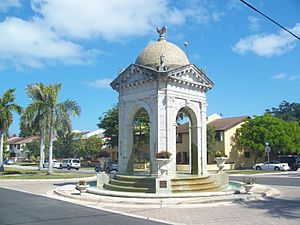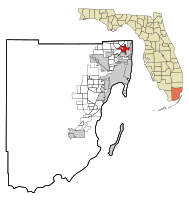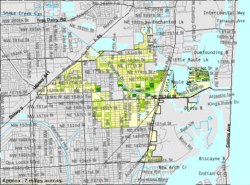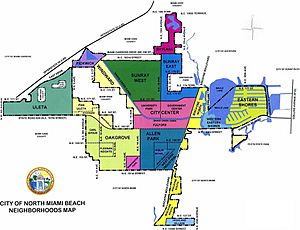North Miami Beach, Florida facts for kids
Quick facts for kids
North Miami Beach, Florida
|
||
|---|---|---|

North Miami Beach in April 2011
|
||
|
||
| Nicknames:
NMB
|
||
| Motto(s):
"Where People Care"
|
||

Location in Miami-Dade County and the state of Florida
|
||

U.S. Census Bureau map showing city limits
|
||
| Country | ||
| State | ||
| County | ||
| Settled (Fulford-By-The-Sea) | 1881 | |
| Incorporated (Town of Fulford) | 1926 | |
| Incorporated (City of Fulford) | 1927 | |
| Incorporated (City of North Miami Beach) | June 15, 1931 | |
| Government | ||
| • Type | Commission-Manager | |
| Area | ||
| • Total | 5.37 sq mi (13.91 km2) | |
| • Land | 4.84 sq mi (12.55 km2) | |
| • Water | 0.53 sq mi (1.36 km2) 6.43% | |
| Elevation | 10 ft (3 m) | |
| Population
(2020)
|
||
| • Total | 43,676 | |
| • Density | 9,016.52/sq mi (3,481.18/km2) | |
| Time zone | UTC-5 (EST) | |
| • Summer (DST) | UTC-4 (EDT) | |
| ZIP Codes |
33160, 33162, 33169, 33179, 33181
|
|
| Area code(s) | 305, 786, 645 | |
| FIPS code | 12-49475 | |
| GNIS feature ID | 287838 | |
North Miami Beach (commonly referred to as NMB) is a city in Miami-Dade County, Florida, United States. The City of North Miami Beach is part of the Miami metropolitan area of South Florida. Originally named "Fulford-by-the-Sea" in 1926, after Captain William H. Fulford of the U.S. Coast Guard, the city was renamed "North Miami Beach" in 1931. The population was 43,676 at the 2020 US census.
Contents
History
The first non-indigenous settlement was platted in 1881, and was called Fulford-By-The-Sea.
In the 1920s, Carl G. Fisher built an all-wooden racetrack with stands for 12,000 spectators, known as the Fulford–Miami Speedway. This event, held on February 22, 1926, dubbed the Carl G. Fisher Cup Race, was a forerunner to the auto races at Sebring and Daytona. In September 1926, after just one race, the track was destroyed by the 1926 Miami Hurricane.
The hurricane of 1926 essentially ended the South Florida real estate boom, and in an effort to alleviate their losses and the damage to the city, local residents came together as the Town of Fulford. In 1927, it was incorporated as the City of Fulford.
Geography
The approximate coordinates for the City of North Miami Beach is located in northeastern Miami-Dade County at 25°55′49″N 80°10′1″W / 25.93028°N 80.16694°W.
It is bordered to the southeast by the city of North Miami, to the southwest by unincorporated Golden Glades, to the west by the city of Miami Gardens, to the north by unincorporated Ojus, to the northeast by the city of Aventura, and to the east across the Intracoastal Waterway by the city of Sunny Isles Beach.
U.S. Route 1 (Biscayne Boulevard) runs through the east side of the city, leading south 11 miles (18 km) to downtown Miami and north 14 miles (23 km) to Fort Lauderdale. Interstate 95 runs along the northwest border of the city, with access from Exit 12.
According to the United States Census Bureau, the city has a total area of 5.37 square miles (13.9 km2). 4.4 square miles (11 km2) of it are land and 0.53 square miles (1.4 km2) of it (9.78%) are water.
Although the North Miami Beach boundaries once stretched to the Atlantic Ocean, the city no longer has any beaches within its limits. They are now a short distance away, within the city of Sunny Isles Beach across the Intracoastal Waterway.
Climate
North Miami Beach has a tropical climate, similar to the climate found in much of the Caribbean. It is part of the only region in the 48 contiguous states that falls under that category. More specifically, it generally has a tropical rainforest climate (Köppen climate classification: Af), bordering a tropical monsoon climate (Köppen climate classification: Am).
| Climate data for North Miami Beach, Florida, 1991–2020 normals, extremes 2000–present | |||||||||||||
|---|---|---|---|---|---|---|---|---|---|---|---|---|---|
| Month | Jan | Feb | Mar | Apr | May | Jun | Jul | Aug | Sep | Oct | Nov | Dec | Year |
| Record high °F (°C) | 86 (30) |
88 (31) |
92 (33) |
94 (34) |
95 (35) |
98 (37) |
98 (37) |
97 (36) |
95 (35) |
94 (34) |
90 (32) |
88 (31) |
98 (37) |
| Mean maximum °F (°C) | 83.2 (28.4) |
85.3 (29.6) |
87.3 (30.7) |
89.5 (31.9) |
91.5 (33.1) |
93.8 (34.3) |
93.3 (34.1) |
93.5 (34.2) |
92.6 (33.7) |
90.8 (32.7) |
86.3 (30.2) |
84.0 (28.9) |
95.1 (35.1) |
| Mean daily maximum °F (°C) | 75.2 (24.0) |
77.0 (25.0) |
79.1 (26.2) |
82.5 (28.1) |
85.4 (29.7) |
88.3 (31.3) |
89.6 (32.0) |
90.0 (32.2) |
88.5 (31.4) |
85.5 (29.7) |
80.5 (26.9) |
77.3 (25.2) |
83.3 (28.5) |
| Daily mean °F (°C) | 67.1 (19.5) |
69.0 (20.6) |
71.3 (21.8) |
75.2 (24.0) |
78.5 (25.8) |
81.5 (27.5) |
82.7 (28.2) |
83.1 (28.4) |
82.0 (27.8) |
79.0 (26.1) |
73.4 (23.0) |
69.7 (20.9) |
76.0 (24.4) |
| Mean daily minimum °F (°C) | 59.0 (15.0) |
61.0 (16.1) |
63.6 (17.6) |
67.9 (19.9) |
71.7 (22.1) |
74.7 (23.7) |
75.8 (24.3) |
76.2 (24.6) |
75.4 (24.1) |
72.5 (22.5) |
66.3 (19.1) |
62.2 (16.8) |
68.8 (20.4) |
| Mean minimum °F (°C) | 43.7 (6.5) |
47.1 (8.4) |
51.3 (10.7) |
58.8 (14.9) |
64.3 (17.9) |
70.7 (21.5) |
71.6 (22.0) |
72.5 (22.5) |
72.1 (22.3) |
63.6 (17.6) |
54.3 (12.4) |
49.7 (9.8) |
41.3 (5.2) |
| Record low °F (°C) | 35 (2) |
37 (3) |
41 (5) |
52 (11) |
54 (12) |
68 (20) |
67 (19) |
70 (21) |
68 (20) |
54 (12) |
45 (7) |
36 (2) |
35 (2) |
| Average precipitation inches (mm) | 2.30 (58) |
2.72 (69) |
2.67 (68) |
3.54 (90) |
5.68 (144) |
9.03 (229) |
8.30 (211) |
9.28 (236) |
10.26 (261) |
7.34 (186) |
4.55 (116) |
2.66 (68) |
68.33 (1,736) |
| Average precipitation days (≥ 0.01 in) | 7.0 | 6.6 | 6.2 | 6.5 | 10.8 | 16.5 | 17.6 | 17.0 | 18.0 | 14.0 | 9.3 | 8.2 | 137.7 |
| Source: NOAA (mean maxima/minima 2006–2020) | |||||||||||||
Surrounding areas
- Miami Gardens, Ives Estates, Ojus, Aventura
- Miami Gardens


 Sunny Isles Beach
Sunny Isles Beach - Miami Gardens, Golden Glades

 Ojus, Aventura, Sunny Isles Beach
Ojus, Aventura, Sunny Isles Beach - Golden Glades


 North Miami
North Miami - Golden Glades, North Miami
Demographics
| Historical population | |||
|---|---|---|---|
| Census | Pop. | %± | |
| 1940 | 871 | — | |
| 1950 | 2,129 | 144.4% | |
| 1960 | 21,405 | 905.4% | |
| 1970 | 30,544 | 42.7% | |
| 1980 | 36,553 | 19.7% | |
| 1990 | 35,359 | −3.3% | |
| 2000 | 40,786 | 15.3% | |
| 2010 | 41,523 | 1.8% | |
| 2020 | 43,676 | 5.2% | |
| U.S. Decennial Census | |||
2010 and 2020 census
| Race / Ethnicity (NH = Non-Hispanic) | Pop 2000 | Pop 2010 | Pop 2020 | % 2000 | % 2010 | % 2020 |
|---|---|---|---|---|---|---|
| White alone (NH) | 10,104 | 7,630 | 7,621 | 24.77% | 18.38% | 17.45% |
| Black or African American alone (NH) | 15,273 | 16,251 | 14,464 | 37.45% | 39.14% | 33.12% |
| Native American or Alaska Native alone (NH) | 66 | 58 | 46 | 0.16% | 0.14% | 0.11% |
| Asian alone (NH) | 1,615 | 1,373 | 1,491 | 3.96% | 3.31% | 3.41% |
| Pacific Islander or Native Hawaiian alone (NH) | 25 | 16 | 4 | 0.06% | 0.04% | 0.01% |
| Other race alone (NH) | 141 | 172 | 366 | 0.35% | 0.41% | 0.84% |
| Mixed race or Multiracial (NH) | 1,317 | 810 | 1,161 | 3.23% | 1.95% | 2.66% |
| Hispanic or Latino (any race) | 12,245 | 15,213 | 18,523 | 30.02% | 36.64% | 42.41% |
| Total | 40,786 | 41,523 | 43,676 | 100.00% | 100.00% | 100.00% |
As of the 2020 U.S. census, there were 43,676 people, 13,617 households, and 9,548 families residing in the city.
As of the 2010 U.S. census, there were 41,523 people, 13,681 households, and 9,462 families residing in the city.
Chinatown
Despite Asians making up only 3.41% of North Miami Beach's population as of 2020, the city's main commercial artery along NE 167th street converging into North Miami Beach Boulevard and then becoming 163rd street, has taken the unofficial name of "Chinatown" due to the large concentration of Asian owned and operated businesses in the area. The area has been referred to unofficially as "Chinatown" since the early 1990s by both locals and North Miami Beach city officials. As of late, even Miami-Dade County officials have begun to reference the area as Chinatown. Local guides and Miami websites have called 163rd street Miami's unofficial Chinatown.
Attractions
Attractions in the vicinity of North Miami Beach include a line of popular Atlantic Ocean beaches, Ancient Spanish Monastery, Oleta River State Park, Greynolds Park, East Greynolds Park, Fulford-by-the-Sea Monument, and Aventura Mall.
North Miami Beach's has a historic 12th century medieval Spanish monastery, the St. Bernard de Clairvaux Church. This stone building around a patio, the cloisters of the Monastery of St. Bernard de Clairvaux, was built in Sacramenia, Segovia, Spain in the 12th century. It was purchased by William Randolph Hearst in the 1920s, dismantled and shipped to the United States, and reassembled after Hearst's death in North Miami Beach in the 1950s. It is a tourism attraction and a popular spot for weddings.
Parks and recreation
In 1966, a major accomplishment was the completion of the tennis complex and two community centers, Victory Park and Uleta Community Center.
In 1968, the Washington Park Community Center was built, and the Allen Park Youth Center was completed in 1973.
North Miami Beach expanded its parks in the 1980s as a result of the city commission making strides to benefit the community.
The city now has the Judge Arthur I. Snyder Tennis Center. It includes twelve lighted clay Hydrogrid tennis courts, six lighted lay-kold hard tennis courts, four racquetball courts, and two paddleball courts. The center also has a clubhouse and pro-shop, a picnic area, and lounge and shower facilities.
Education
Primary and secondary schools
Miami-Dade County Public Schools serves North Miami Beach.
Public elementary schools
- Fulford Elementary School
- Greynolds Park Elementary School
- Madie Ives Elementary School
- Oak Grove Elementary School
- Ojus Elementary School
- Sabal Palm Elementary
Public middle schools
- Highland Oaks Middle School
- John F. Kennedy Middle School
Public high schools
- Alonzo and Tracy Mourning Senior High Biscayne Bay Campus
- Dr. Michael Krop Senior High School
- North Miami Beach Senior High School
Prior to the opening of North Miami Beach High and Krop, students from North Miami Beach were assigned to Miami Beach High School and Miami Norland High School.
Private schools
- Yeshiva Toras Chaim
- Beth Jacob High School
- Allison Academy
- Toras Emes Academy Klurman Elementary School
- Young Leaders Academy K–8
- Fulford Christian Academy
Colleges and universities
- Nova Southeastern University – North Miami Beach Campus
Public libraries
North Miami Beach Public Library (NMB Library), also referred to as the Lafe Allen Public Library, is a 23,000 square foot facility located at 1601 NE 164th Street in North Miami Beach, Florida. The library's collection currently contains over 60,000 items, including both fiction and non-fiction materials, DVDs, audio books, compact discs, newspapers, magazines, and foreign language materials. Digital services include access to e-materials and reference resources, such as Florida Electronic Library, Newsbank, Reference USA, World Book, NoveList Plus, and more.
In 1959, the North Miami Beach Library was initially opened inside of a storefront on NE 163rd Street as a branch of the Miami-Dade Public Library System (then known as the City of Miami Library system). This location was relocated and expanded to two storefronts at the corner of NE 19th Avenue and NE 169th Street the following year. In 1961, however, the city ended its attachment with the City of Miami Library system and became an independent library. During this time, the library was merely a staff of two. The staff had a minor budget of 25,000 to build the collection for the library. After residents of the City of North Miami Beach voted to build a permanent location for the library in 1964, a new building was constructed on 164th Street and opened in 1965. Renovations to this facility in 1981 and 1994 grew the branch from its original 10,000 square feet to make room for the library's expanding collection. The last reservation took place in 1994 and granted the facility its current dimensions at over 23,000 square feet.
The NMB Library offers a variety of services to the residents of North Miami Beach, such as access to study and meeting rooms, employment resources, early literacy programs, voter registration forms, citizenship materials, and passport assistance. Computers, printers, copiers, scanners, and fax machine services are also available. The library's dedicated teen area, known as the Discovery District, is a space specifically designed to provide library patrons aged 13–19 with a place to read, study, or work on school projects. Access to computers, 3D printers, virtual reality, and zSpace for educational and recreational purposes is also provided.
Notable people
- Garcelle Beauvais, actress and television personality
- Andrea Bocelli, Italian tenor
- Johnathan Cyprien, NFL safety
- Louis Delmas, former NFL safety
- Paul Gleason, film and television actor
- Max Jean-Gilles, former NFL guard
- MC Jin, rapper, actor, and comedian
- Larry Kahn, tiddlywinks player
- Marlins Man, sports fan and lawyer
- Brad Meltzer, novelist, non-fiction writer, TV show creator, and comic book author
- Cheryl Patton, Miss Florida USA 1967, Miss USA 1967
- Sheryl Sandberg, technology and business executive, philanthropist, and writer
- Jonathan Zaslow, sports radio show host
See also
 In Spanish: North Miami Beach para niños
In Spanish: North Miami Beach para niños



